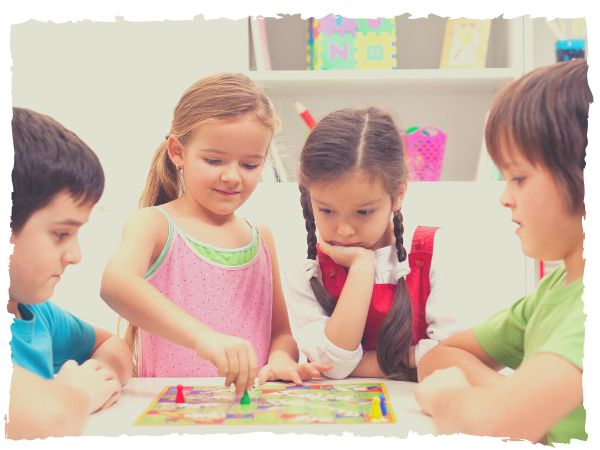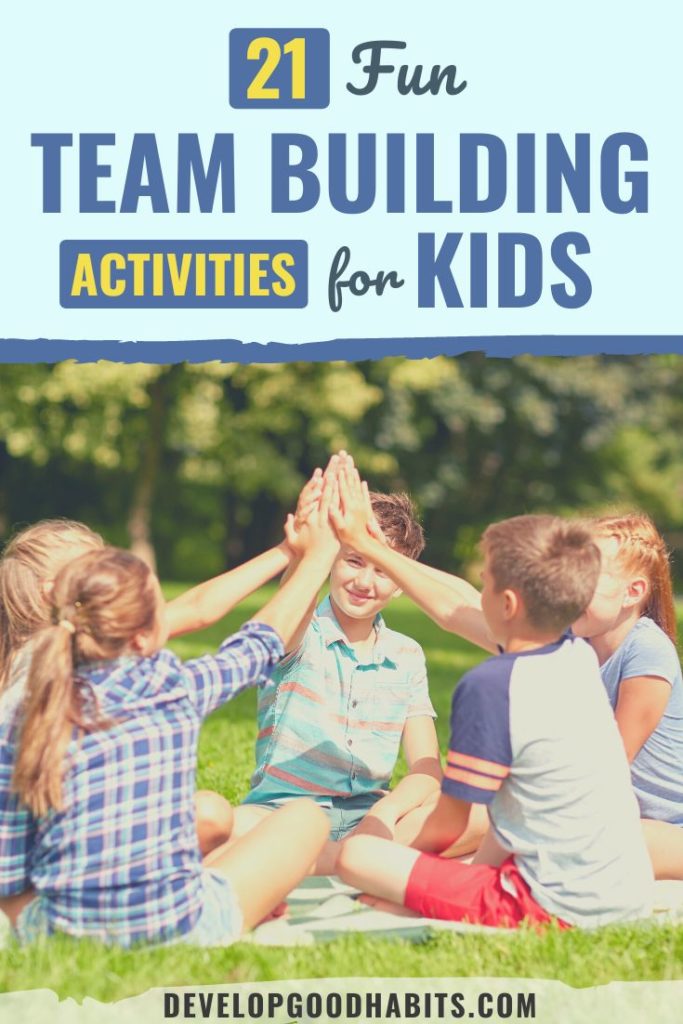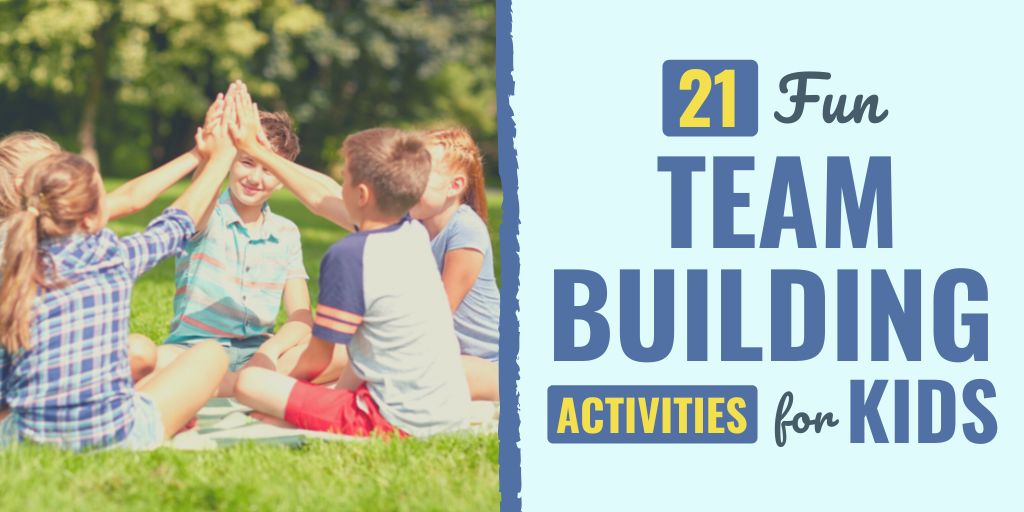There might be affiliate links on this page, which means we get a small commission of anything you buy. As an Amazon Associate we earn from qualifying purchases. Please do your own research before making any online purchase.
Are you looking for activities that teach valuable lessons to kids? Team building activities help kids socialize and bond with other children their age. Kids need to know how to work together and respect one another, so they grow into well-adjust adults.
Team building activities teach useful lessons to kids, all while having fun. The goal is to help kids create long-lasting friendships and provide tools to help them succeed in the future.
What Are Team Building Activities?
Team building activities involve a group working together to achieve a common goal. There are various forms of team building activities, such as physical exercises, puzzles, arts & crafts, and mindfulness exercises. Activities can last as little as minutes or for days. It all depends on the type of activity and the goal of the assignment.
Team members participate in activities that challenge them to solve problems as a group. The objective is to work together and celebrate the group’s accomplishments, which results in a deeper connection between peers and puts aside individual differences. The point is to depend on your teammates as they depend on you.
Why Team Building Activities for Kids Are Important
Socialization is one key component of a child’s development. During socialization, a child begins to experience empathy, improve language skills, and grow confidence. Team building exercises increase socialization skills by breaking the ice and creating meaningful friendships with other children.
Also, these types of activities help children understand the importance of comradery. Like sports, team building activities positively affect a child’s school performance and peer relationships. Individual accomplishments should be celebrated, but group accomplishments allow children the benefit of sharing that celebration. As a result, children better understand their peers and continue to do so throughout their lives.
Team building exercises are easy and fun to include in any children’s gathering. You can have them at birthday parties, family events, school, or summer camp. No matter the occasion, children should routinely participate in team building exercises to help improve their development.
So, today we’re going to cover 21 activities for you to try out with your kids!
1. Draw My Mind
Activities that put children in others’ shoes help improve empathy and social skills. All you need is a few pieces of paper, crayons, and random photos. The children must draw what the other child sees. This game requires strong communication and will bring about many laughs!
Steps:
- Have two kids sit back to back.
- Hand paper and crayons to one kid and a photo to the other.
- The child with the photo must describe the image to the other kid.
- The goal is to be as accurate as possible.
Materials:
- Paper, crayons, and kid-friendly photos such as a dog, cat, house, etc.
2. Team Scavenger Hunt
Working together to solve a puzzle helps kids understand the importance of teamwork. Put kids into small groups and hand each group different scavenger hunts. They are hunting for puzzle pieces! Groups should encourage each other to find their fair share of the puzzle so everyone can complete it.
Steps:
- Get a puzzle and hide the pieces.
- Split the group into four smaller groups.
- Give a unique scavenger hunt to each group to find the missing puzzle pieces.
- When a group finishes the hunt before the other groups, let them join the other groups to help.
- Once all the pieces have been found, let the group complete the puzzle.
3. Write a Short Play
Imagination drives creativity. Kids should be able to explore their artistic side without the fear of being judged by others. Kids who are shy can benefit the most from this activity. They will experience kindness and acceptance from their peers.

It also helps them get out of their shell and become more social. As they act out their story, the kids will feel accomplished and proud of the story they just created together.
Steps:
- Have the kids sit down in a circle.
- Begin by saying, “Once upon a time, there was a….”
- The kids will take turns adding to a story.
- As the adult, write the story down so they can act it out later.
Materials:
- Paper and pencil
4. Be My Eyes
This activity encourages kids to trust one another through communication. One kid must hold an egg on a spoon while blindfolded and complete an obstacle course without dropping the egg! The group must help them navigate the course by shouting directions to help.
Steps:
- Set up the obstacle course and have the group choose one kid to be blindfolded.
- The other kids must stand a distance and help their friends through the course.
- If the kid drops the egg, then another kid must take their spot and start from the beginning.
- Once a child makes it through without dropping the egg, the team has won!
Materials:
- Blindfold, egg, spoon, and obstacle course.
5. Did You Hear That?
We all need a little help sometimes. Depending on others can make kids feel confident and builds trust with their peers. This activity teaches kids that we can rely on others to do a great job.
This game requires a kid to be blindfolded and to stand in the middle of a circle. The kids in the circle must pass a noisy object around without the blindfolded kid hearing them. When the object has made it around the circle, the group wins!
Steps:
- Pick a kid to be blindfolded. They will stand in the middle of a circle of kids.
- Kids forming the circle must pass the object around the circle without making noise.
- If the kid in the middle hears a noise, they must point to that area. If the kid is correct, the group loses, and another kid is picked to be in the middle.
- The group wins when they can pass the object around the circle without detection.
Materials:
- Blindfold and a noisy object. Such as a can of marbles, plastic bags, or bells in a jar.
6. Tight Space
Physical challenges are always fun for kids to learn about personal space and boundaries. Tight Space requires children to fit inside a confined space. The group must work together to find the most comfortable and creative position to fit as many kids as possible.
Steps:
- Split the group into smaller groups.
- Have kids work together to fit inside the space.
- Let them communicate and experiment with the space.
- The group with the most kids within the space wins.
Materials:
- Hula hoop, rope, or any object to create a confined space.
7. Whose Birthday is it?
Communication without words is challenging. Kids will have fun trying to communicate while completing this activity. This game requires no talking as they must line each other up depending on the challenge. The first challenge will ask them to line up in order by birthday. It is up to them to line up correctly without speaking to their peers.
Steps:
- Prepare a set of challenges for the kids to line up.
- Instruct them that they cannot talk.
- If someone talks, the group must go on to the next challenge.
- Examples of challenges:
- Line up in order of your birthday
- Line up in order of the color of your shoes
- Line up in order of your height
8. Balloon Drop
Prepare for screams of delight with this activity. Groups must form a circle and work together to keep a certain amount of balloons in the air. This activity helps control impulsiveness, as kids must rely on each other to keep the balloons afloat. The group with the most balloons in the air wins.
Steps:
- Blow up five or more balloons.
- Separate kids into small groups.
- Kids must stay glued to their spots and not move their feet.
- Kids must keep their balloons in the air for a certain time.
- If a kid moves their feet, they must sit out and wait for the next game.
- The group with the most balloons in the air wins.
Materials:
- Balloons
9. Human Letters
Kids love moving. This activity promotes moving their bodies while thinking critically. For the best experience playing this game, the kids should be old enough to know how to spell four-letter words. In a team, kids must make letters with their bodies to form total words. They must race against other teams, create the shape, and spell the word correctly to win.
Steps:
- Separate kids into teams with five kids on each team.
- Make sure kids have plenty of room around them.
- Shout out a word from the list.
- Kids must work together to spell the word out on the ground with their bodies.
- The fastest group to spell the word wins.
Materials:
- List of four-letter words.
10. Magic Stick
Sometimes life doesn’t go the way you plan. Some things should be easy, but they turn out to be challenging. Kids will understand how simple it is for things to go wrong fast with this activity. It requires groups to think quickly to prevent a magic stick from floating away.
Working together to keep the magic stick in the air requires patience and communication from everyone in the group. In the end, the kids will understand things aren’t as easy as they appear.
Steps:
- Separate kids into small groups.
- Kids must keep the magic stick (balloon) from floating away.
- Kids must only use one finger each to touch the balloon.
- They cannot let the balloon touch the ground.
- If a balloon flies away, the group is disqualified.
- The group that still has its balloon by the end of the game wins.
Materials:
- Helium and modelling balloons.
11. Queen’s Treasure
Queen’s Treasure is a combination of Capture the Flag and Dodgeball. Groups must work together to cross into another group's base to capture treasure inside a circle. If a ball is thrown at a team member, they are out!

Teams must strategize and create gameplays to capture more treasure than the other team. Kids get innovative with this game, and it’s surprising to see how well they create intelligent strategies.
Steps:
- Divide the area with the rope to create two bases.
- Line dodgeballs alongside the rope.
- Place one hula hoop on opposite sides of the dodgeballs and place the treasure inside.
- Kids must stand beside their hula hoops.
- On GO, kids must run and grab a dodgeball.
- The goal is to run into the other team's base and capture their treasure.
- Once the treasure is caught, they must return it to their own treasure.
- They must do all of this without getting hit with a ball.
- If they are hit with the ball, they must let go of the treasure and return to their side.
- The team with the most treasure is the winner.
Materials:
- Dodgeballs, rope, two hula hoops, and treasure (toy coins).
12. Egg Nest
A famous science experiment turned group activity! Kids must work together to protect their precious eggs from shattering. Teams must build contraptions to protect their egg from a 10ft drop. Give them random material and let them get creative with their inventions. In the end, the team with their egg intact wins!
Steps:
- Set a timer and let the kids work together to create a nest for their egg.
- In the end, begin dropping their nests, with the eggs, from a safe height.
- Drop the nest 1 foot from the ground.
- Then drop the nest at 2 feet, 3 feet, and so on.
- Continue to drop the nests further from the ground until all but one egg breaks.
Materials:
- Eggs, cardboard, glue, rubber bands, cotton balls, and anything else you’d like.
13. Trust Circle
Creating a safe space for kids means they must understand how important it is to feel safe. The trust circle teaches kids to care for and protect one another. It also helps them get out of their comfort zone and become a little more social.
We want our children to feel empathy for their peers, and this activity helps them practice. All you need is for a group of kids to stand in a tight circle around one kid and catch them as they fall.
Steps:
- Have a group of kids stand in a circle, preferably shoulder to shoulder.
- Pick one kid to stand in the middle.
- Have the kid in the middle put their hands across their chest.
- Have them gently fall back into the circle
- Kids in the circle must gently push them away to the other side.
- Have each kid have a turn in the middle to experience the trust circle.
14. Sinking In
Working with a team to tackle an impossible task can help kids motivate one another. Sinking In requires a team to submerge a basketball using only hockey sticks. As the ball splashes and rolls around, kids must work together to find the best way to keep the ball underwater.
Steps:
- Divide the group into three teams.
- Throw the basketball into the middle of the pool.
- Kids must use only their hockey sticks to keep the ball underwater.
- The team that can hold their ball underwater the longest wins.
Materials:
- Three basketballs, pools of water, and hockey sticks.
15. Spending Spree
Knowing how to keep finances secure is a valuable skill. This activity helps kids understand the importance of listening to their teammates for advice. Spending Spree creates a scenario where kids must spend money on necessities.
The group must determine what is necessary and what is not. Some groups may spend their money on frivolous expenses like video games, while others may understand the importance of buying enough food for everyone. Kids will learn from one another the best ways to spend their money.
Steps:
- Tell each team they must survive a week with their money.
- Let them decide what they will spend their money on.
- In the end, help them figure out if their team will survive at the end of the week.
Materials:
- $100 fake dollars per team and a list of how much items cost.
16. Fix the Leak
Working together under pressure can be tough. This activity requires fast action and communication. It can show kids how valuable teamwork is when the stakes are high. The game requires a pipe with leaks to be patched as soon as possible, as water runs through it.
By the end of the game, the team with the most water in their bucket wins. Fix the Leak is a great lesson to teach kids patience and composure. It will also challenge them to respect one another as tensions are sure to get high.
Steps:
- Place the pipe on a table with one spout leading to a bucket on the ground.
- Put the hose through the other end of the pipe.
- Turn the water on.
- Kids must use their roll of duct tape to patch as many leaks as possible.
- The kids with the most water in their bucket wins.
Materials:
- A plastic pipe with holes, a table, a bucket, a roll of duct tape, and a water hose.
17. Floor is Lava
Like adults, some kids have selfish tendencies and look out for themselves. This activity helps kids understand the importance of helping their neighbors. They must depend on their teammates to get them to safety.
And their teammates must survive the game to win. It helps kids realize that there is no I in team. Kids act as if the floor is lava and use mats to get from one end of the room to another. They only have a limited amount of mats, so working together requires communication and trust.
Steps:
- Have kids start on one end of a room.
- They must use their mats as stepping stones to get to the other side.
Materials:
- Small rectangular and movable mats.
18. Contamination
No one likes to be a black sheep. Kids must learn to treat everyone equally and respect one another. Contamination requires kids to help their fellow teammates get out of a harmful situation. The game acts outs a deadly virus that is sweeping the nation.
Kids who are infected must grab a partner to help cure them. Their partner must go through an obstacle to find the cure for their partner. The team with the least infected wins the game.
Steps:
- Separate the group into two teams.
- Make half of each group contaminated.
- You can contaminate randomly by saying, “Kids with blue eyes are contaminated.
- A contaminated kid must ask a non-contaminated kid to find the cure.
- The non-contaminated kid must go through the obstacle course and retrieve the cure.
- Once a kid is cured they can help their other teammates.
Materials:
- Obstacle course and “the cure.”
19. Giant’s Shadow
Imagination and creativity can help a child strive for greatness in the future. Activities that challenge their imagination can also improve their confidence. Also, this game requires problem-solving as each kid will have different physical boundaries.
Kids work together as they try to create the tallest shadow. Watch and see how they communicate and strategize with one another. They’ll brainstorm and come up with new ideas on how to win the game.
Steps:
- Have kids bring mats outside.
- They must all try to create the tallest shadows using only their bodies.
- Make sure kids are safe on the mats so they are safe if they fall.
Materials:
- Soft mats
20. Splash Zone
Splash Zone is a fun way for everyone to get soaked. The team must work together to pass water between buckets. No one is safe, and this game builds comradery and shows everyone must pay their dues. Kids also love water sports, so they won’t mind getting wet for the team!
Steps:
- Have kids stand in a straight line between the kiddy pool and the water hose.
- The first kid in line will fill their bucket with water.
- Then the first kid will throw their water and try to make it into the second kid's bucket.
- The kids will continue to throw their water around to make it into the kiddy pool.
- The team must get as much water in the kiddy pool as possible.
Materials:
- One bucket per kid, kiddy pool, and water hose.
21. SOS
Kids can help each other think critically by sharing their ideas. SOS separates teams and gives them survival objects. The goal of the game is to get two of each survival object by trading with other teams. Teams must work together to decide what is best for the group. The team with the best communication and understanding will win this game.
Steps:
- Separate the group into three teams.
- Give each team three identical survival tools.
- Have kids choose a leader for each group.
- Each leader will visit groups to negotiate what they wish to trade.
Materials:
- Cut-outs of survival tools such as: bottles of water, food, shelter, etc.
Final Thoughts on Team Building Activities for Kids
One of the best ways to teach kids a lesson is through games. These team building activities for kids can help them socialize and build confidence. Kids will love to engage with others and create friendships along the way.
Kids of all ages will enjoy these games. But if your kid is a little older, they may find these games too childish. If that’s the case, we also have Team Building Activities for Teens!


